Saturday, April 02, 2005
Æ antoninianus, Gallienus, Rome, Göbl 463q¹
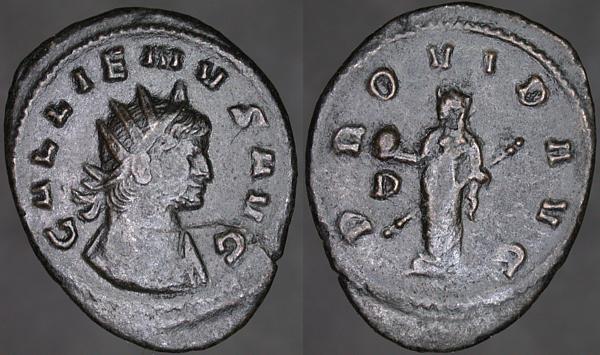
GALLIENVS AVG, Radiate cuirassed bust right | PROVID AVG, Providentia standing facing, head left, holding globe left and transverse scepter. P in left field.
Providentia is honored as the source of imperial foresight and planning, and the benefits thereof.
Friday, April 01, 2005
Æ28, Koropissos in Cilicia, Valerian, SNG Levante 160 (this coin)
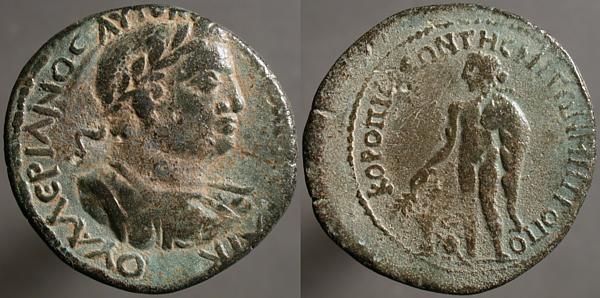
OYAΛEPIANON AYTOK[...], Laureate draped cuirassed bust right | KOPOΠI[CC]EΩN THC KHTΩN MHTPOΠO, Apollo Smintheus standing facing, head right, holding branch over altar and crouching mouse left, chlamys draped over arm right.
I'm a sucker for a coin from a city I don't already have, like this, from the site of modern Dağpazarı, in Turkey. It strikes me that the obverse bears a resemblance to Laughton's Nero, call it a portrait of a generic Roman.
The reverse is quite distinctive, though. We've seen Apollo Smintheus (the mouse hunter) before, at Alexandria Troas, here we also see the mouse, and learn that another translation is "mouse-god".
Apollo's apparently huge and misshapen arm is, in fact, a chlamys that he has removed and draped over his arm. This reverse (in fact, perhaps this same die) was used at this city for many emperors.
Thursday, March 31, 2005
Billon antoninianus, Valerian, Rome, Göbl 15d
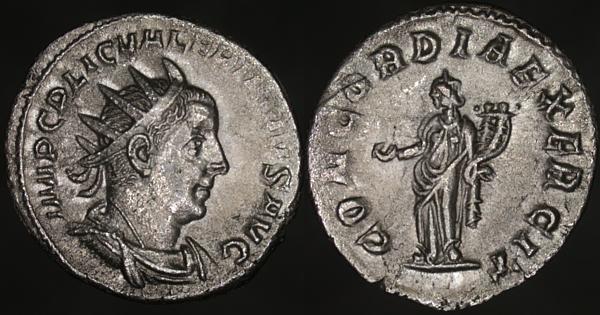
IMP C P LIC VALERIANVS AVG, Radiate draped cuirassed bust right | CONCORDIA EXERCIT, Concordia standing facing, head left, holding patera left and double cornucopias right.
An early issue from the mint of Rome, while the coins still contained an appreciable amount of silver, noting concord with the army, without which no emperor could long retain his office, or his life.
Wednesday, March 30, 2005
AR antoninianus, Balbinus, Rome, 238 CE, RIC 10
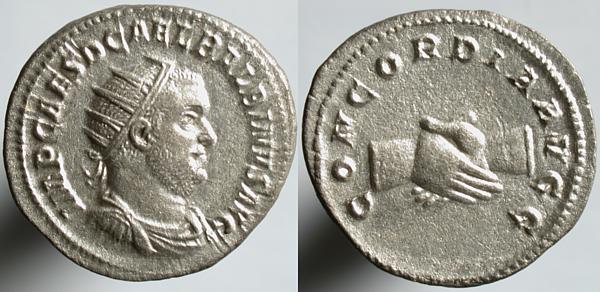
IMP CAES D CAEL BALBINVS AVG, Radiate draped cuirassed bust right| CONCORDIA AVGG, Clasped hands.
While Maximinus I still reigned, the Senate declared him a public enemy and sanctioned the uprising of Gordian I and his son Gordian II who had been acclaimed by landowners in Roman Africa. They were not successful, reigning March 22, 238 - April 12, 238, and their coins, while available, are more expensive than I'm willing to pay. The Senate next settled on Decius Caelius Calvinus Balbinus and Marcus Clodius Pupienus Maximus as suitable replacements.
Balbinus is remembered as the favorite of the wealthy patricians, and got along poorly with his partner, said to have failed to protect themselves from assassination in July 238, each fearing a ruse by the other.
Tuesday, March 29, 2005
Æ19, Prusias ad Hypium in Bithynia, Valerian, SNG von Aulock 913
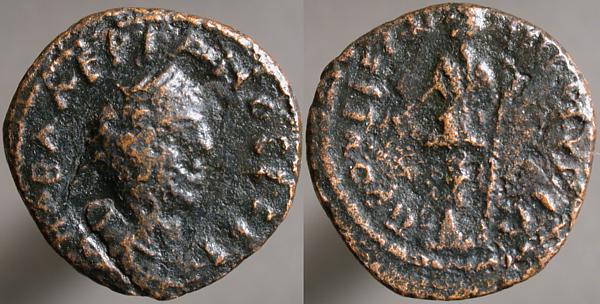
Π [Λ] BAΛEPIANOC CEB, Laureate bust right | ΠΡOVCIEΩN [ΠΡOC] VΠIΩ, Demeter standing facing, head left, holding grain ears left and long torch right.
The dealer correctly attributed this as a coin of Valerian, but incorrectly as being from the province of Troas, near where Heinrich Schliemann found the remains of Troy.
I knew that couldn't be right. There are only two cities in Troas that minted during the time of Valerian: Alexandria Troas and Ilium.
Alexandria Troas minted coins that weren't much bigger than this 19mm item (about the size of a US cent), but, as a colony city the coins had legends in Latin, and this coin has legends in Greek.
Ilium minted quite large coins, and they spelled Valerian OVAΛEPIANOC. This was from one of the smaller number of cities that spelled it BAΛEPIANOC.
I could clearly read the beginning of the reverse legend, ΠΡO and maybe V. A quick browse through Sear's Greek Imperial Coins showed two Bithynian cities as worth checking: Prusa ad Olympum (a OVAΛEPIANOC city, check it second) and Prusias ad Hypium (a city not otherwise represented in my collection,) where they spelled Valerian BAΛEPIANOC. SNG Copenhagen didn't show this coin, but did show others of about this size. Lindgren & Kovacs and Lindgren III were no more rewarding. SNG von Aulock produced a match, and this beat-up coin, which cost me all of $10, provided an evening of entertainment that it wouldn't have if it'd come with a complete and correct attribution.
Monday, March 28, 2005
Billon antoninianus, Valerian, Rome, Göbl 110b...
(same obverse die)
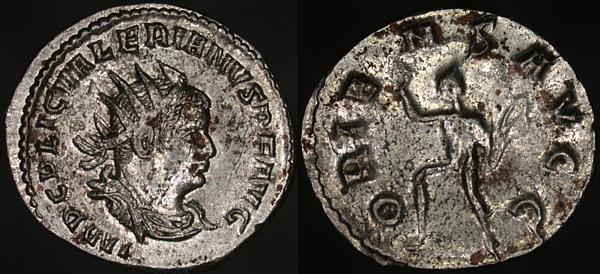
IMP C P LIC VALERIANVS P F AVG, Radiate draped cuirassed bust right | ORIENS AVGG, Sol, wearing chlamys, advancing left, holding whip right and raising hand left.
It's not very unusual to find two provincial coins with one or both sides struck from the same dies, since the provincial cities struck relatively few coins. It is unusual to find matching dies on imperial antoniniani of this period, since they were struck in very large numbers and any given die is seen on only a tiny fraction of them.
This obverse, though, clearly matches the one in the example of this coin plated in Göbl, particularly noticeable around that rather glum-looking mouth. That doesn't mean a heck of a lot, I realize, if you don't have Göbl, but I think it's cool.

IMP C P LIC VALERIANVS P F AVG, Radiate draped cuirassed bust right | ORIENS AVGG, Sol, wearing chlamys, advancing left, holding whip right and raising hand left.
It's not very unusual to find two provincial coins with one or both sides struck from the same dies, since the provincial cities struck relatively few coins. It is unusual to find matching dies on imperial antoniniani of this period, since they were struck in very large numbers and any given die is seen on only a tiny fraction of them.
This obverse, though, clearly matches the one in the example of this coin plated in Göbl, particularly noticeable around that rather glum-looking mouth. That doesn't mean a heck of a lot, I realize, if you don't have Göbl, but I think it's cool.
Sunday, March 27, 2005
Æ26, Kolophon in Ionia, Gallienus, SNG Copenhagen 201
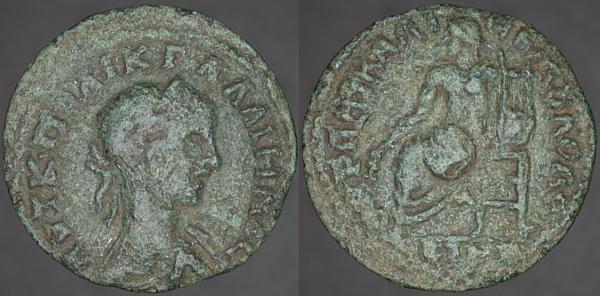
AVT K ΠO ΛIK ΓAΛΛIHNOC, Laureate draped cuirassed bust right | EPI CTP ΠO KAΛINEIKOV KOΛOΦ[...], Apollo seated left holding lyre right and laurel branch left.
A rather ugly, clumsy portrait of the emperor paired with an artistic view of a languid Apollo. Presumably the reverse is an older die from a different hand, although it names a magistrate, Kalaneikou, and such offices were usually annual.

